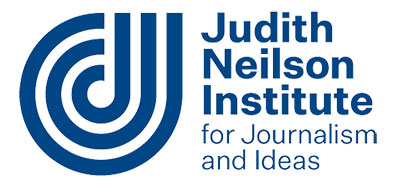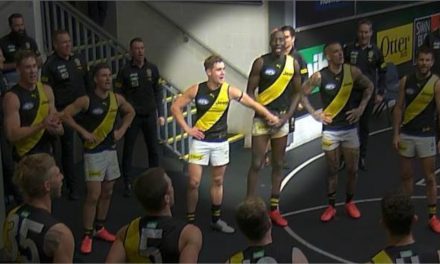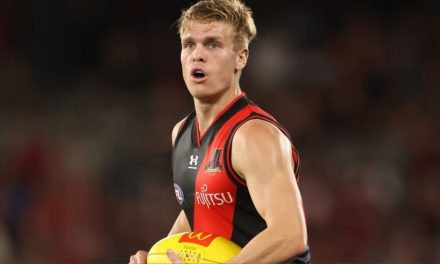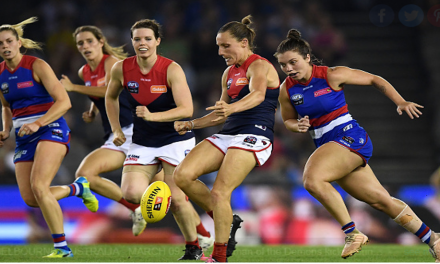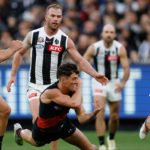Adelaide star Erin Phillips celebrates a Crows’ goal during the 2019 AFLW grand final. (Inset): Hawthorn coach Bec Goddard.
Sadly, there is an asterisk on the mahogany honour boards at AFL House in Melbourne. Amid the determination to “find a way” to complete the AFL premiership campaign, the game’s leaders failed to crown a 2020 AFLW champion.
While it is AFL chief executive Gillon McLachlan’s great regret from the scramble created by the COVID pandemic, the man who fast-tracked the national women’s league has not been hit with a secondary reason to repent. Hitting the pause button did not stop the women’s game from improving and growing.
AFLW season No.5 is generally regarded as the best since McLachlan cut the ribbon on the top-flight women’s competition at Princes Park in suburban Melbourne in 2017.
The proof might just be from noting much-heard Port Adelaide AFL premiership player Kane Cornes saying: “The improvement (in AFLW) has been there year on year, but this year has seen the biggest leap – skill-wise and athletically.
“That always was going to happen. It took some time to get here. But the standard this season is good, very good. To the point we are getting more competitive, higher-scoring matches.”
AFLW 2020 was wrecked amid the uncertainty and turmoil of the COVID pandemic. Even with the finals series brought forward by a fortnight – after the last two rounds of the home-and-away series were scrapped – there was not enough time to finish the AFLW season before the 12-week COVID lockdown.
The race to the fourth AFLW premiership was cancelled on March 22 after North Melbourne, Fremantle, Carlton and Melbourne had qualified for the preliminary finals.
The most-remarkable note about the AFLW advancing – rather than regressing – after the shutdown last year is the progress made while grassroots competitions were completely cancelled.
“Other than Adelaide, Brisbane and Perth,” says inaugural AFLW premiership coach Bec Goddard, “there was no competition for thousands during the winter. And still the quality of women’s football has improved.”
Goddard, who led Adelaide to the 2017 premiership, was one of the COVID victims with her return to coaching – with Hawthorn in the Victorian state competition – put on hold until this year.
Her observations on the growth of women’s Australian football are most relevant for her knowledge of the big league – while commentating AFLW games for Channel 7 – and from the grassroots, and not just in Melbourne considering her deep connections in Adelaide, Darwin and her original base in Canberra.
The key note is the women. They are unstoppable in their determination to play the game they love. At Hawthorn, an AFL club waiting for its AFLW licence, Goddard has players who have sought out extra development in their own time. They have supplemented their training by working with former Collingwood goalkicking star Travis Cloke, who lost his place in the AFL system with the COVID-forced cuts and has returned to the grassroots.
Rather than sit back waiting for the uncertainties of COVID to pass, these passionate women at Hawthorn and beyond have worked harder to succeed in a game defined by men for more than a century.
At SANFL club Glenelg, a Darwin-based player presented herself unannounced at training last month eager to find more competition – and more opportunity to build a path to the AFLW. How does anyone, even after settling on the regulation 40-woman SANFLW squad, say “no” to such ambition?
The women’s game is thriving from such willingness to take on the demands of an ultra-demanding code that is still very much amateur in remuneration – but strikingly professional in its approach and work ethic.
“The quality (of AFLW) this year is notably better – and that comes from the fitness levels of the players being significantly better. They look like athletes,” says Goddard.
“Adelaide’s work in strength and conditioning has allowed its players to be better in other parts of the game. The big one (in the advancement of the women’s game) is the players’ composure with the football.”
Going – if not gone – is that raw football seen in 2017 when AFLW was bash, crash and smashed for being a low-scoring “unsophisticated” game. The language on the modern graffiti wall – Twitter on social media – had changed to draw more praise than vile remarks about the state of women’s football and the AFL’s commitment with multimillion-dollar budgets that were protected amid the cutbacks felt elsewhere by the COVID pandemic.
Tackle numbers have fallen from 2017 as a result of more composed players understanding the benefit of creating time and space by holding the ball rather than quickly throwing it to a boot.
Adelaide premiership sensation Ebony Marinoff has noted the challenge of a fast-improving competition. Fewer stoppages, says Marinoff “and you are seeing the girls have the ability to break the lines”.
“It is a more free-flowing game,” she adds. “It has definitely evolved during my five years in the AFLW.”
The men’s league took more than a century to find its national agenda. The women’s game has been asked to make its mark even quicker.
“There is still work to be done,” says Kane Cornes. “Particularly in the way the players protect themselves. That is a real issue. Players still get hurt. They put themselves in vulnerable positions and they don’t know what to do (when exposed to collision). That is having an impact on the injury rates in the game.
“But on the whole, it has been exceptional (the growth of AFLW).”
It began in 2017 with eight clubs – Adelaide, Brisbane, Carlton, Collingwood, Fremantle, Greater Western Sydney, Melbourne and the Western Bulldogs – and great scepticism, even from some AFL club presidents who have completely changed their thinking.
There was expansion with Geelong and North Melbourne in 2019 and Gold Coast, Richmond, St Kilda and West Coast added last season. This leaves AFL clubs Essendon, Hawthorn, Port Adelaide and Sydney to advance to the AFLW … and Goddard having changed her initial views on expanding the women’s league.
PLEASE HELP US CONTINUE TO THRIVE BY BECOMING AN OFFICIAL FOOTYOLOGY PATRON. JUST CLICK THIS LINK.
“All AFL clubs need AFLW teams now – and I would not have said that in 2017,” Goddard told Footyology. “Then, I felt if we went too big too soon we would damage the product. Now we need to get those final four clubs involved as quickly as possible. This league is not going backwards – it will be a forward step to have every AFL club involved in the AFLW competition.”
Goddard’s vision is for a league with part-time players – and “part-time opinions” – ultimately being fully accepted and represented at Australian football’s table, where the big decisions are made. It is a repeat of tennis along the gender lines in the 1970s – and, like the men’s tennis game, there can be much to gain in Australian football with a stronger and complete women’s code. Sponsorship and government money is more accessible with women involved in sport.
“And the game will be better for full-time players,” says Goddard.
So far, the AFL has developed from passion to fitness levels – and tactics await.
“North Melbourne with (coach) Darren Crocker has started working a defensive system,” Goddard notes.
There certainly will not be a lack of talent. Goddard recalls Adelaide’s AFLW premiership in 2017 sparked one area of the Adelaide football map to grow from six teams to 66 – and set up the challenge of finding more coaches, umpires, volunteers and money to build new changerooms with women-specific facilities.
Every sport needs heroes – or heroines (as defined by courage, outstanding achievements or noble qualities). The AFLW’s first pin-up heroine clearly was Erin Phillips, daughter of Australian Football Hall of Famer, Port Adelaide premiership champion and former Collingwood defender Greg Phillips.
When the AFLW began in 2017 with the predictable debate on whether a woman could advance to the AFL, Phillips gave the ultimate reply: “We have a league of our own.
“It’s not realistic — and I am not even sure it is flattering,” added Phillips when she was crowned the inaugural AFLW “Brownlow medallist”. I’ve said before, in my opinion I don’t think I could play in the AFL. And I don’t even like to compare (men and women footballers).
“We have a league of our own. I’m part of a league that fits for me – and for other women. It is a league in which women compete against other women. The AFL is for men to compete against men.
“I have the AFLW. And with the AFLW, that means my daughter will never have to face the same moment if she chooses to play footy. That’s why I have loved the AFLW. That opportunity for women to follow their dream means more to me that the question of whether I could make it in the AFL.
“I don’t clearly remember the moment when mum and dad sat me down at 13 to explain why I couldn’t play footy any more with the boys. It was confusing to me and frustrating.
“But I am so glad I will never have to say that to my daughter Emily if she ever decides to play. Giving that opportunity to women is why I have loved the AFLW — and why this league means more to me.”
During the 2019 AFLW grand final between Adelaide and Carlton – in a full Adelaide Oval – there was a moment when Crows’ co-captain Chelsea Randall could have drawn comparisons with AFL greats Nick Riewoldt and Jonathan Brown for her courageous lunge into a marking contest at half-forward at the Torrens River end.
It seemed anything but condescending to wonder how many AFL players Randall could outperform (let alone expose) with her uncompromising approach to the contest.
“No-one comes close (for courage),” says Adelaide teammate Teah Charlton of Randall’s approach to contests. “Crazy.”
Randall certainly made a mockery of a column written by inaugural Crows AFL coach Graham Cornes in 2015, when he argued women just did not look like footballers.
“Perhaps it was the outfits,” Cornes wrote in his weekly newspaper column in Adelaide after noting the women had skills, balance, fitness, aggression and the competitive edge that defines good sportspeople.
“But there was something amiss. They wore boys’ footy jumpers and shorts. Not particularly flattering.” He added: “Apart from the few who really looked like footballers, most of them looked like girls playing football. Boobs and all.”
Randall looks like a footballer regardless of the team outfits.
“She plays the game in a way that gender does not come into it,” says Goddard. “She is graceful under pressure. She is the definition of courage. On and off the field. She came into the AFLW already looking like an athlete. And she has taken that to the next level. What Chelsea always had was that eagerness to attack the contest – and that grace under pressure.”
There is still the debate on when the game will generate more women to not only coach in the AFLW but also become accepted in men’s programs – and well beyond just shuffling the paperwork in AFL football departments.
What happens when there is a full list of AFLW teams – and perhaps expansion to the richly deserving Northern Territory market? Tasmania? Where does the AFLW fit on the football calendar – both with venues and television timeslots? How many games make up an AFLW home-and-away season that this year has nine rounds while carrying 14 teams? Do AFLW games become curtain raisers to AFL matches – or vice versa?
Not in question is the financial contribution the AFLW can make when many corporate sponsors – aware of the female control on the household budget – would prefer to attach their brands to women’s football rather than AFL advertising billboards.
The AFLW has survived negativity, cynicism and the COVID pandemic to pick up in 2021 with greater promise than in any other season, while adding a $10 charge to entry to matches. So what is the next big challenge?
“The next step is equality,” says Goddard. “We can’t have – as has been the case in life, industry and sport so often – that women are of a lower value than men. That is when you run the risk of being overlooked and ignored.”
*Footyology thanks Hawthorn Football Club and Bec Goodard for their time for this article.


